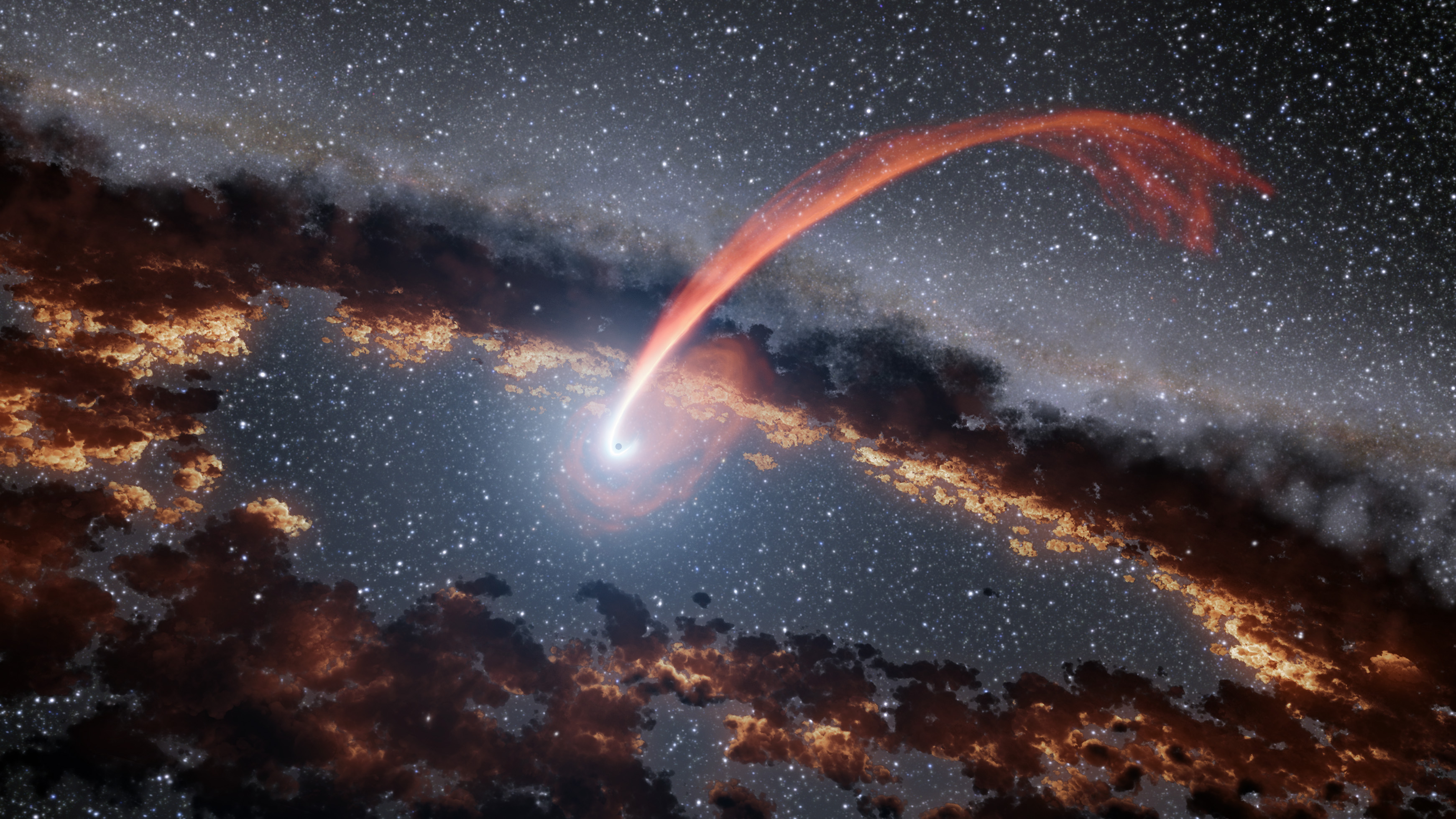Hungry black hole is transforming star into a stellar taffy and a cosmic donut
"This is an exciting place for scientists to be: Right at the interface of the known and the unknown."
Astronomers have discovered a monstrous black hole with an appetite and a sweet tooth. The black hole is ripping apart an unfortunate star, stretching it like taffy and shaping the "leftovers" into a stellar donut the size of the solar system before feasting on this cosmic confectionary.
The All-Sky Automated Survey for Supernovae (ASAS-SN or "Assassin") first spotted the violent incident, referred to as a tidal disruption event (TDE), via a flash of high-energy radiation. The feast is taking place at the heart of a galaxy 300 million light-years away.
Astronomers followed up observations of the flash by inspecting the scene at the center of the galaxy ESO 583-G004 in ultraviolet light using the Hubble Space Telescope. Though Hubble is too far away from this TDE, designated AT2022dsb, to spot the fate of the star as it unfolded, the team of astronomers was able to recreate the scene using light from the doomed star.
Related: Black hole announces itself to astronomers by violently ripping apart a star
The spectra of the star revealed how it was ripped apart by the black hole before being stretched like taffy and being fed into the black hole. The TDE process left the cosmic monster surrounded by a donut-shaped torus of stellar material and superheated gas and while much of this material will gradually fall into the black hole, some will escape into space.
Black holes are messy eaters
Thus far, telescopes including Hubble have spotted around 100 of these violent interactions between black holes and stars that wander too close to them, triggering destruction by the tidal forces created by the black hole's immense gravitational influence. What makes the observation of AT2022dsb special is that it was made in ultraviolet light, whereas most TDEs are observed in X-ray light.
"There are still very few tidal events that are observed in ultraviolet light given the observing time," Harvard–Smithsonian Center for Astrophysics (CfA) researcher Emily Engelthaler said in a statement. "This is really unfortunate because there's a lot of information that you can get from the ultraviolet spectra."
Breaking space news, the latest updates on rocket launches, skywatching events and more!
The team that observed TDE AT2022dsb using ultraviolet spectroscopy was able to monitor it for a longer period than usual from its beginning to later stages of the "feeding" or "accretion."
"Typically, these events are hard to observe. You get maybe a few observations at the beginning of the disruption when it's really bright. Our program is different in that it is designed to look at a few tidal events over a year to see what happens," CfA researcher Peter Maksym said. "We saw this early enough that we could observe it at these very intense black hole accretion stages. We saw the accretion rate drop as it turned to a trickle over time."
TDEs have shown astronomers that black holes are "messy eaters," meaning some of the material left over from the destruction of unfortunate stars in these feeding events will be blown out into space, possibly as jets of matter moving at incredible speeds approaching that of light.
This TDE is no different. The team's observations reveal a stellar wind sweeping toward Earth at a speed of around 3% the speed of light, or about 20 million miles per hour (approximately 32.2 million kilometers per hour).
Changes in what remains of the star destroyed in the TDE AT2022dsb are occurring over a timescale of days to months, meaning that ultraviolet spectroscopy and observations of these changes can tell astronomers more about the feasting black hole.
"We're excited because we can get these details about what the debris is doing. The tidal event can tell us a lot about a black hole," Engelthaler added. "We're excited because we can get these details about what the debris is doing. The tidal event can tell us a lot about a black hole."
Read more: Black holes: Everything you need to know
Observing the edge of a cosmic donut
The spectroscopic data from AT2022dsb collected by Hubble was analyzed by the team who believe that it is coming from a very bright, hot, donut-shaped area of gas that was once the star's constituent material.
They were also able to ascertain that this torus of gas that swirls around the black hole is around the size of our solar system. The observations are taken from somewhere on the edge of the donut according to Maksym.
"We really are still getting our heads around the event," Maksym concluded. "You shred the star and then it's got this material that's making its way into the black hole. And so you've got models where you think you know what is going on, and then you've got what you actually see.
"This is an exciting place for scientists to be: Right at the interface of the known and the unknown."
The team's findings were announced at the 241st meeting of the American Astronomical Society on Wednesday, Jan. 12.
Follow us on Twitter @Spacedotcom or on Facebook.

Robert Lea is a science journalist in the U.K. whose articles have been published in Physics World, New Scientist, Astronomy Magazine, All About Space, Newsweek and ZME Science. He also writes about science communication for Elsevier and the European Journal of Physics. Rob holds a bachelor of science degree in physics and astronomy from the U.K.’s Open University. Follow him on Twitter @sciencef1rst.


